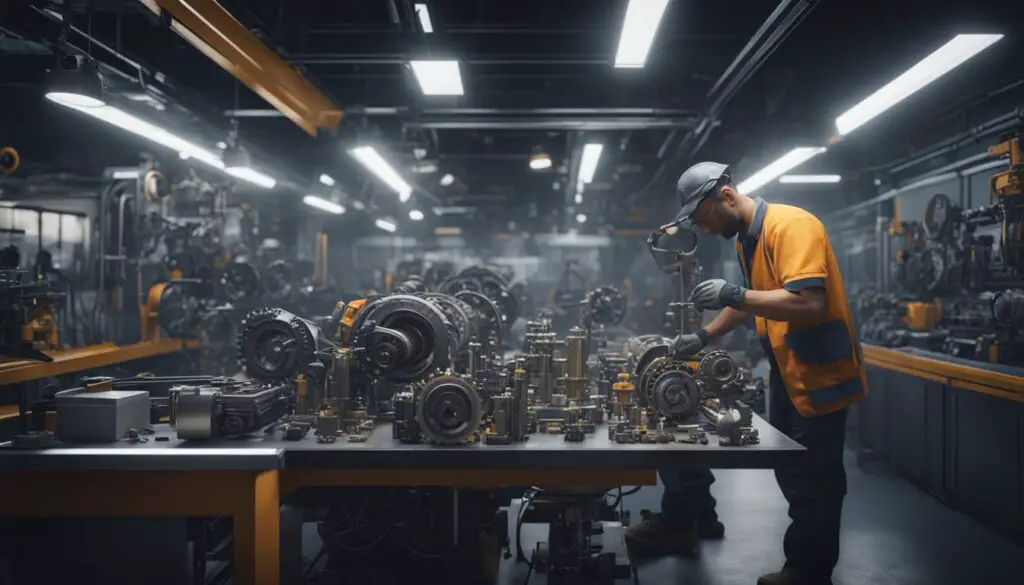When you’re tackling challenging terrain or managing tasks on your farm, your Can-Am Defender is a reliable partner. Yet, like any complex machine, it’s not immune to issues, and one area that might give you trouble is the transmission. Can-Am Defender transmission problems often manifest as difficulty in shifting gears or the transmission’s inability to engage at all. This is an aspect of your vehicle that you need to watch closely because any hiccups in the transmission can affect your experience and the UTV’s performance.
Related problems:
– Can-Am Defender AC Problems: Common Issues and Solutions
– Can-Am Defender Loss of Power: Common Causes (+Solutions)
– Can-Am Defender Fuel Pump Problems: Common (+Solutions)
– Can-Am Defender Power Steering Problems: Causes (+Fixes)
– Can-Am Defender Ignition Switch Problems: Tips and Tricks

Understanding common transmission troubles with your Can-Am Defender can help you address them before they escalate. You might encounter symptoms like excessive heat from the engine when in use, especially if you’re moving at a crawl or for extended periods. Another telltale sign of a potential transmission problem could be an inexplicable slippage during gear changes, pointing towards the need for a prompt inspection. Low transmission fluid, worn clutch plates, or a faulty shift solenoid are common culprits behind these issues.
Being proactive with regular maintenance and keeping an eye out for the warning signs can save you time and money in the long run. If you’re experiencing any of these issues, it’s important to get your Can-Am Defender checked out. Handling it sooner rather than later can ensure that your time on the trails or on the job remains as enjoyable and efficient as you expect.
Understanding Can-Am Defender Transmission Basics
The transmission system of your Can-Am Defender is integral to its operation, seamlessly transferring power from the engine to the drive wheels. Let’s dive into the essential components and functions that make your transmission work effectively.
Components of the Transmission System
Your Can-Am Defender’s transmission system comprises several key components that work in harmony to deliver smooth shifting and reliable operation. At its heart:
- Gears: Large and small gears within the system determine the torque and speed.
- Shift Mechanism: Allows the selection of appropriate gear ratios.
- Output Shaft: Connects to driveshafts that power the wheels.
- For models equipped with a Continuous Variable Transmission (CVT), this system relies on belts and pulleys instead of traditional gears to provide a seamless range of gear ratios.
Transmission Fluid Dynamics
The transmission fluid in your Can-Am Defender plays a crucial role in:
- Lubrication: It reduces friction and wear between the moving parts.
- Cooling: It dissipates heat generated by operation.
- Pressure Application: It enables gear changes in automatic transmissions.
Note: Always ensure the transmission fluid is at the correct level and condition to prevent issues such as shifting problems or internal damage.
Role of the Clutch in Transmission
The clutch system connects and disconnects the engine from the transmission to allow gear changes. In a Can-Am Defender:
- Clutch Plates: When you engage the clutch, these plates separate to interrupt power flow for shifting.
- Clutch Pedal/Handle: This is where you control the engagement and disengagement of the clutch system.
- In CVT models, the transmission doesn’t require a traditional clutch as the system adjusts automatically without the need for manual gear changes.
Common Transmission Issues and Symptoms
Your Can-Am Defender’s ability to power across rough terrain is essential, and the transmission’s health is crucial for a smooth ride. Let’s break down some of the most common transmission issues you might encounter and how they present themselves.
Low Transmission Fluid Levels
Low transmission fluid levels are often behind a host of transmission problems. If you notice that your transmission fluid is lower than it should be, it can lead to:
- Insufficient lubrication which might result in internal parts wearing out faster.
- Overheating, as the fluid also functions as a coolant.
To avoid potential damage, regularly check your fluid levels and top up if necessary.
Grinding Noises During Gear Shifts
If you hear a grinding noise when shifting gears, it’s a symptom not to be ignored. It typically means:
- The clutch isn’t engaging properly.
- There could be debris in the transmission fluid.
This noise is a clear indication that your transmission needs attention sooner rather than later.
Transmission Overheating Signs
Overheating is a red flag for any vehicle component, particularly the transmission. Be on the lookout for:
- A burning smell, which is a telltale sign of overheating.
- Transmission slipping, which can happen if the transmission is too hot.
Keep your transmission’s cooling system well-maintained to prevent overheating during your rides.
Difficulty in Shifting Gears
Struggling to shift gears smoothly is a common symptom of transmission issues. This may manifest as:
- Hesitation when trying to shift.
- The transmission not engaging or delaying when you shift.
Regular maintenance and checks can prevent shifting problems from ruining your adventure.
Transmission Maintenance and Regular Checks
To keep your Can-Am Defender running smoothly, a keen focus on transmission health is vital. This includes staying on top of fluid levels and clutch system health, as well as being aware of typical signs of wear and tear.
Periodic Fluid Checks and Replacement
Regular checks and replacement of your transmission fluid can prevent numerous problems. Maintaining the proper level and quality of fluid is key to avoiding gear shifting issues and ensuring that your transmission components remain well-lubricated.
- Check Fluid Levels: At least every 50 hours of operation, or according to your user manual.
- Fluid Quality: Look for signs of contamination or degradation. Discoloration or a burnt smell indicates the need for a change.
- Change Interval: Replace the transmission fluid as recommended by the manufacturer or more often in harsh riding conditions.
Clutch System Inspections
Clutch health is crucial for smooth gear engagement and power transfer. Regular inspections can help you spot early signs of clutch problems or belt slippage, saving you from more extensive repairs down the road.
- Belt Inspection: Assess for cracks, wear, or fraying. Replace if necessary to avoid slippage or breakdown.
- Clutch Cleanliness: Keep the clutch area free of debris and build-up that can impede performance.
Common Wear and Tear Observations
Regular maintenance isn’t just about fluid and filters; it’s also about recognizing the typical wear your transmission might endure. By identifying issues early, you prevent minor concerns from becoming major repairs.
- Shift Cable: Look for damage or looseness that could impede gear shifting.
- Transmission Filter: Replace as part of regular maintenance to keep the system clean.
- Listen and Feel: Watch for unusual noises or vibrations that could indicate internal transmission wear or failure.
Troubleshooting Specific Transmission Problems

When your Can-Am Defender starts exhibiting transmission troubles, it’s crucial to address the problem swiftly to prevent further damage. This section will guide you through resolving some of the most common transmission issues, ensuring your vehicle performs optimally.
Analyzing and Fixing Grinding Noises
If you’re hearing grinding noises from your transmission, it often points to a problem with the gears. Incorrect clutch adjustment or worn-out gears can be the culprits. Here’s what you can do:
- Check the transmission fluid level; low fluid can cause grinding.
- Inspect the clutch components for wear and replace if necessary.
- Ensure that the gear linkage is properly adjusted.
Resolving Overheating Issues
An overheated engine can lead to serious transmission problems. Overheating can be attributed to low coolant levels or a blocked radiator.
- First, verify your coolant levels and top up if they’re low.
- Check the radiator for blockages and clean it to improve airflow and cooling.
- Consider seeking a mechanic’s expertise if overheating persists, since it may indicate a deeper issue.
Correcting Shifting Challenges
Shifting issues can manifest as difficulty changing gears or the inability to shift at all. To tackle these challenges:
- Examine the shift cable for damage; replace it if you find any signs of wear.
- Test the shift solenoid; a failure here might require professional repair.
- If the problem persists, it might be in the gearbox, and professional diagnostic tools would likely be needed to delve deeper.
External Factors Affecting Transmission Health

In maintaining the health of your Can-Am Defender’s transmission, it’s crucial to consider not just the mechanical aspects but also external factors. These variables can significantly impact the performance and longevity of your transmission.
Impact of Off-Roading and Mud
When you take your Can-Am Defender off-roading, it’s exposed to mud, which is more than just messy. Mud can clog the external parts of your transmission and even seep into the internals if seals are compromised. This can lead to increased wear and overheating. After off-roading, it’s wise to inspect your vehicle for mud build-up and clean it thoroughly to prevent these issues.
Consequences of Hauling and Towing
Hauling heavy loads or consistent towing puts extra strain on your transmission. Your Can-Am Defender is designed to handle tough jobs, but pushing past its recommended towing capacity can heat up the transmission fluid and stress the components. To preserve transmission health, stick within the recommended capacities and take breaks during long hauls to prevent overheating.
Influence of Dust and Dirt Accumulation
Dust and dirt are almost inevitable, especially on trails or during dry spells, and they’re not just an annoyance—it’s a transmission’s enemy. Particles can infiltrate the system, leading to abrasive wear or clog the air filter, which is critical for preventing your transmission from overheating. Regularly check and replace your air filter and keep an eye out for dirt accumulation to ensure proper transmission ventilation and cooling.
Advanced Transmission Care for Enhanced Longevity

Taking care of your Can-Am Defender’s transmission involves more than just regular maintenance. Advanced strategies centered around utilizing top-notch components, cooling, and optimizing airflow can markedly extend the life of your vehicle’s transmission system.
Utilizing High-Quality Replacement Components
When it’s time for repairs or maintenance, choosing high-quality replacement components is crucial for the longevity of your transmission. Ensure that replacement parts such as clutch plates and shift solenoids meet or exceed the OEM specifications. This can prevent premature wear and potential failure, saving you from future costly repairs.
- Clutch Plates: Always opt for plates that offer high resistance to wear and heat.
- Shift Solenoid: Select solenoids known for reliability and precise operation.
Proactive Transmission Cooling Strategies
Your transmission’s temperature is a key player in its longevity. Integrating a high-performance radiator and cooling fan can significantly decrease the heat it experiences during operation.
- Radiator Upgrade: Install a larger or more efficient radiator to enhance cooling capacity.
- Cooling Fan: A robust cooling fan helps in maintaining optimal temperatures, especially under heavy loads.
Remember to monitor the temperature and consider investing in a transmission temperature gauge to keep an eye on it in real time.
Ensuring Optimal Airflow
Adequate airflow helps to dissipate heat from your transmission. Implementing measures to ensure good airflow can make a substantial difference in maintaining a lower operating temperature.
- Heat Shield: Use a heat shield to protect your transmission from excessive heat exposure.
- Airflow Path: Remove any obstructions and consider modifications that allow air to flow freely around the transmission.
Implementing these strategies can result in a cooler and happier transmission, leading to fewer issues and a longer life span for your Can-Am Defender’s transmission system.
Professional Repair and Service Guidance
When facing transmission issues with your Can-Am Defender, it’s important to know when to consult a mechanic, understand the costs and procedures associated with repairs, and how to choose the right services for your needs.
When to Seek a Mechanic’s Help
If you’re experiencing difficulty shifting gears, hearing unusual noises when the transmission is in operation, or your Can-Am Defender refuses to move, it’s time to see a professional. Mechanics have specialized diagnostic tools to accurately determine the issue and the expertise to address complex transmission problems.
Understanding Repair Costs and Procedures
Repair costs can vary significantly based on the severity of the transmission issue. For an accurate estimate, a mechanic will need to perform a thorough inspection. Here’s what you might expect:
- Diagnostic fee: This covers the cost of identifying the problem.
- Parts replacement: Costs include the price of new parts such as clutch plates or a shift solenoid.
- Labor: Charged hourly, labor costs reflect the time spent on your repair.
Selecting Expert Services for Transmission Issues
Choose a service center that specializes in professional maintenance of Can-Am vehicles. Look for:
- Certifications: Ensure mechanics have the right qualifications.
- Warranties: Professional services often provide warranties on parts and labor.
- Reputation: Read reviews and ask for recommendations from other Can-Am owners.
Remember, regular professional maintenance can prevent many common transmission problems, so don’t hesitate to schedule regular check-ups for your Defender.
Frequently Asked Questions
In this section, you’ll find concise answers to common concerns about your Can Am Defender’s transmission, helping you identify, diagnose, and address issues effectively.
What are the common signs of transmission issues in a Can Am Defender?
If your Can Am Defender has transmission problems, you might notice symptoms such as unusual noises during gear shifts, hesitations while accelerating, or the inability to change gears smoothly. Pay attention to these signs as they can indicate underlying transmission issues.
How can I diagnose a transmission problem in my Can Am Defender?
To diagnose a transmission issue, check the transmission fluid level and quality first. If the fluid is low or dirty, it could be the culprit. Listen for strange noises or feel for changes in the transmission’s behavior when shifting. If you’re uncertain, consult a professional mechanic.
What steps should I take if I’m experiencing gear shifting difficulties with my Can Am Defender?
When facing gear shifting problems with your Can Am Defender, start by checking the transmission fluid for correct levels and condition. Next, inspect the shift cables or linkages for any damage or misalignment. If these steps don’t resolve the issue, seek professional mechanical advice.
Are there any known transmission recalls for Can Am Defenders from recent years?
As of my knowledge cutoff date, there have been no widespread transmission recalls for the Can Am Defender line. However, always check with your dealer or the manufacturer for the most up-to-date recall information for your specific UTV model and year.
Which years of the Can Am Defender are known to have the most transmission problems?
Transmission issues in the Can Am Defender series aren’t extensively documented by year. However, it is recommended to research specific models and years for owner feedback and known issues, as some production runs may have more reports of transmission problems than others.
How does turf mode on the Can Am Defender affect transmission performance?
Turf mode in your Can Am Defender disengages one rear wheel for less aggressive traction. While this can reduce damage to sensitive terrain, you should use it with care as it may affect the overall handling and should not be engaged during intense driving conditions where full traction is required.

Leave a Reply